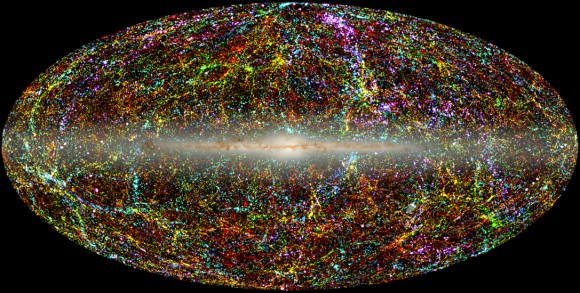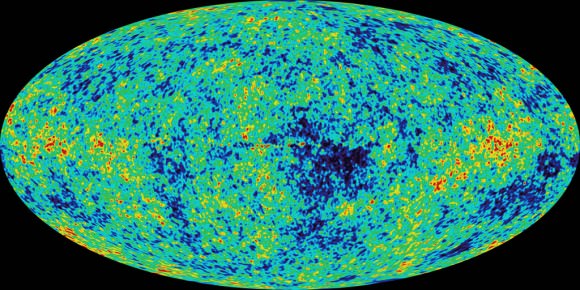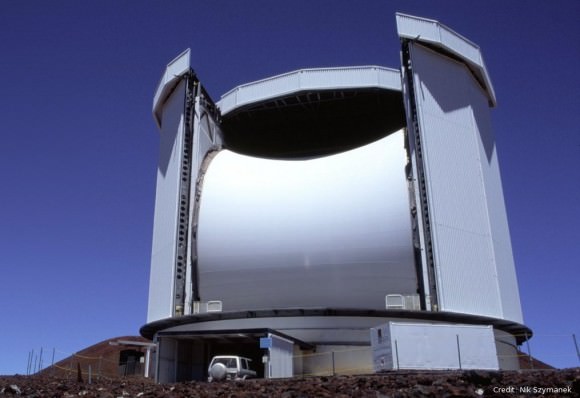[/caption]
The stars and faint galaxies you see when you look up at the night sky are all emitting light within the visible light spectrum — the portion of the electromagnetic spectrum we can see with our unaided eyes or through optical telescopes. But our galaxy, and many others, contain huge amounts of cold dust that absorbs visible light. This accounts for the dark regions.
A new camera recently unveiled at the James Clerk Maxwell Telescope (JCMT) in Hawaii promises to figuratively shed light on this dark part of the universe. The SCUBA-2 submillimetre camera (SCUBA in this case is an acronym for Submillimetre Common-User Bolometer Array) can detect light at lower energy levels, allowing astronomers to gather data on these dark areas and ultimately learn more about our universe and its formation.
Light is measurable; its intensity or brightness is measured by photons while colour is measured by the energy of the photons. Red photons have the least energy and violet photons have the most energy. This can also be thought of in terms of wavelengths. Light at longer wavelengths have less energy and light at shorter wavelengths have more energy. This continues beyond the visible light spectrum. As electromagnetic waves get shorter, we get ultraviolet light, x-rays, and gamma rays. As wavelengths get longer, we get infrared light, submillimetre light, and finally radio waves.

On the longer end of the electromagnetic spectrum, infrared and radio telescopes have been around for decades helping astronomers understand more about the universe. But this is only part of the picture. The cold dust that absorbs the visible light to create the dark regions seen through optical telescopes is actually absorbing the light’s energy and reemitting it at longer wavelengths in the submillimetre region.
The first submillimetre camera, SCUBA, was designed and constructed at the Royal Observatory in Edinburgh in collaboration with the University of London. In 1997, it was up and running at the JCMT. Observations of submillimetre wavelengths are typically harder to gather — it takes a long time to image a small portion of the sky in this region. Nevertheless, submillimetre observations have already revealed a previously unknown population of distant, dusty galaxies as well as images of cold debris discs around nearby stars. This latter finding could be an indication of the presence of planetary systems.
A team of astronomers has recently developed the camera SCUBA-2 that can probe the submillimetre region with increased speed and much greater detail. But it’s a touchy instrument. Director of the JCMT Professor Gary Davis explains that for SCUBA-2 to detect extremely low energy radiation in the submillimetre region, “the instrument itself needs to be [extremely cold]. The detectors… have to be cooled to only 0.1 degree above absolute zero [–273.05°C], making the interior of SCUBA-2 colder than anything in the Universe that we know of!”

The camera is a huge step in observational astronomy. Director of the United Kingdom Astronomy Teaching Centre Professor Ian Robson likened the technological leap between early sub-millimetre cameras and SCUBA-2 to the difference between wind-on film cameras and modern digital technology. “It is thanks to the ingenuity and abilities of our scientists and engineers that this immense leap in progress has been achieved,” he said.
Dr Antonio Chrysostomou, Associate Director of the JCMT, explains that SCUBA-2’s first task will be to carry out a series of surveys throughout the sky, mapping sites of star formation within our Galaxy, as well as planet formation around nearby stars. It will also survey our galactic neighbours and look into deep space to sample the youngest galaxies in the Universe. This latter task will be critical in helping astronomers understand how galaxies have evolved since the Big Bang.
The SCUBA-2 camera is housed on the 15 metre (about 50 foot) diameter JCMT situated close to the summit of Mauna Kea, Hawaii, at an altitude of 4092 metres (about 13,425 feet). It is typically used to study our Solar System, interstellar dust and gas, and distant galaxies.
Source: Revolutionary New Camera Reveals Dark Side of the Universe



This structure has features similar to the CMB. Both are fractals and have a similar appearance with filaments. This makes me ponder whether they have the same Hausdorff dimension. Both are due to the same physics which generated the anisotropy of the universe. It then only makes a measure of sense that if these structures are due to the same physics in the early universe then they should bear a relationship.
LC
The third image is credited to the WMAP team, so should shouldn’t the caption read “The infant Universe as imaged in the microwave wavelength spectrum.”? [Emphais mine.]
And as regards the coldness of the operating temperature of the camera, colder temperatures are achieved by condensed-matter physics experiments. To create a Bose-Einstein condensate, for example, the experiment is required to achieve temperatures below a millionth of a Kelvin.